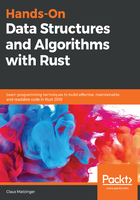
The Rust language
Many of the established programming languages today are multi-paradigm languages, but still remain focused on the principles of object orientation. This means that they have classes, methods, interfaces, inheritance, and so on, none of which can be found in Rust, giving it a steep learning curve for many established developers.
As a multi-paradigm language, Rust has many functional concepts and paradigms that guide it, but they make traditional object-oriented patterns more difficult to apply. Other than organizing code without classes and interfaces, there are various methods to handle errors, change the code itself, or even work with raw pointers.
In the following sections, we want to explore a few concepts that make Rust unique and have a major influence on the way we develop algorithms and data structures.